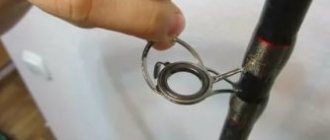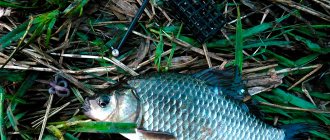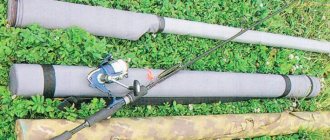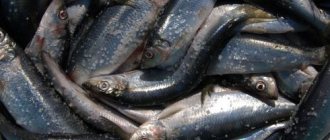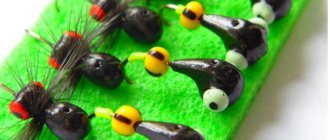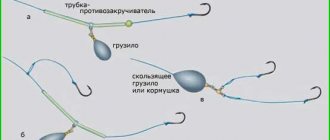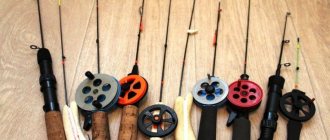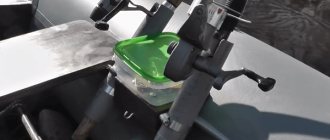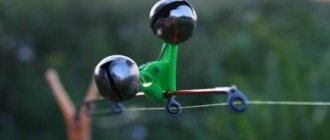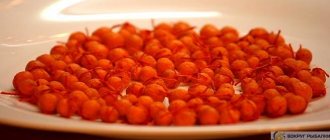My experiments with making a homemade feeder already in the 21st century were forced. I just happened to be moving to a new house, and as you know, one move is equal to three fires... After this “fire,” when everything had already been decided and put in place, it turned out that many of my gear “went somewhere” during the move.
And we just decided to go fishing. Literally before leaving, it turned out that the only way to fish was with old hooks, donks and float rods. Meanwhile, summer time required more subtle and sensitive gear. I had to experiment with quickly manufacturing some kind of feeder. And I must say these experiments were crowned with success, well, not one hundred percent, but the Russian feeder turned out to be quite functional.
True, miraculously there were no casualties or injuries when testing the new gear. The British cat Felix was sleeping, it turns out, in the yard of our new house, when I went out into the yard with some new gear and threw a feeder weighing 40 grams towards the cherry bush, where the well-fed gray lazy man was dozing...
The feeder plopped down next to him, almost hitting the cat’s fat carcass. But it all worked out... And the rod, without much effort, sent the feeder about twenty meters away, which was quite enough for the forest river where we were going fishing.
As a feeder rod, I used a fairly rigid telescopic spinning rod made in China with a test weight of 20-40 g. It had not been used for its intended purpose for a long time, but here it came in handy. Having removed the top, I placed a homemade quivertip made from spring piano wire on the second knee.
However, this was a middle register string from a piano, which I have in stock for the needs of one of my professions and jobs. In the future, if the experiment was successful, I intended to make the guard retractable so that the wire would move in a tube attached to the knee of the rod. Why not replaceable feeder tips?
At the end of the tricky quiver tip I placed a large-diameter spinning “tulip”. For better visibility during the bite, I marked the tip of the guard with red electrical tape. I placed a simple spinning reel on the rod.
samodelkifish.ru
Although my favorite method of fishing is spinning, sometimes when fishing I had to find myself in situations where spinning fishing was unsuccessful, and it was impossible to switch to something else - I didn’t take other gear with me. In general, I don’t have much of this other gear - a couple of telescopic fishing rods and boxes with equipment for them, but when I go spinning, I take them very rarely, it’s either-or, and the fishing places are different, and even the mood for specific fishing method. But not so long ago I found a way out of this situation for myself, or rather, Oleg Bezzubenko suggested it to me.
The first lesson was last year - when he and I went to the Urals, I was with a spinning rod, he seemed to be too, but he also took a box of fishing tackle with him. Our spinning fishing turned out to be fruitless, and it seemed too early to go home, and then Oleg opened the box with fishing tackle, took out an anti-twist with a feeder, a leash with a hook, and a bag of bait from his backpack. He equips his spinning rod with this, turning it into a kind of feeder, mixes the bait and after fifteen minutes begins to carry crucian carp. Not giants, of course, the size of a palm, but against the backdrop of a spinning rod without biting it looked very fun. Fortunately, Oleg also found equipment for me, and soon I joined him. The result is three dozen crucian carp for two.
I made a conclusion for myself - in my fishing tackle box I now have several anti-twisters, feeders of different weights and shapes, equipped with leashes, and in the trunk I almost always have a bag of bait.
As for the rod, I don’t go fishing for crucian carp often enough to buy a special feeder, and the disadvantage of my spinning rod, which I, if necessary, equip with a feeder, is the low sensitivity of the tip. (Mikado Vogle River, 2.40 m, test 50-100 g. I practically never fish with it, I carry it as a spare, just in case.) That is, bites are visible when the crucian carp has already taken “specifically”.
And again, the solution to this problem was suggested by Oleg Bezzubenko. He also implemented it on my spinning rod. The idea is not new - an additional sensitive tip, and most likely, a similar design has already been described somewhere, but I don’t think that we are violating anyone’s copyright.
The essence of the idea: a piece of tube from a telescopic antenna with a diameter of four millimeters and a length of 25 millimeters is wound onto the tip of the spinning rod. The winding is filled with epoxy resin.
A new one is made from fiberglass rod tops sold in fishing stores - about 25 cm long. Its end should fit tightly into the tube. By changing the thickness (diameter) of the new tip using sandpaper, you can achieve the required sensitivity. Then a tulip and an additional ring are installed on it, and the whip itself is covered with bright varnish.
If necessary, you can make several such tips, with different sensitivity.
This is where all the alterations end. As soon as you have the desire to catch crucian carp (and maybe even carp) using a feeder rig, attach the tip, install an anti-twist with a feeder, a leash, and go ahead.
There is no point in doing a similar manipulation with a spinning rod, the test of which is less than 10-30, the feeder with bait weighs significantly more than 30 grams, and it will not last long. And in general, if you are seriously involved in crucian carp fishing, it makes sense to purchase a real feeder. Well, if from time to time, 3-4 times per season, as I do, the above is a completely acceptable option.
www.prospinning.ru
Which feeder should a beginner choose?
The first step is to assemble the rod. The feeder rod consists of 3 parts that are connected using a plug-in method.
The fourth element is a replaceable tip. Manufacturers include 3 or 5 interchangeable tips with the fishing rod. They have different hardnesses, which are designated by ounces (OZ). The tips are marked 0.5; 1; 1.5; 2 OZ. The lower the value, the softer the tip. They are stored in plastic tubes:
The main parameters of the feeder are:
- Length
- Test
- Build
Feeders have a length of 3.3; 3.6; 3.9; 4.2; 4.5 meters. The test indicates the maximum weight that can be cast with a given rod. It is indicated directly on the feeder form:
Manufacturers play it safe and underestimate test values by at least 30 grams. Models with dough up to 60 grams are called light, with dough up to 100 grams - mediums, with dough up to 150 grams - heavy. Rods with a weight of more than 150 grams are considered extra heavy.
Feeder fishing technology
The first stage of feeder fishing consists of feeding:
- in order to bait one place, fishermen use an object on the opposite bank, for example, a tree, as a guide;
- fill the feeder with food and throw it at the point where you will fish;
- after the feeder splashes down, you must immediately close the line guide and clamp the line with a clip (thus, the next throw will be the same length as the previous one);
- after the bait feeder reaches the bottom (the tension of the fishing line disappears), you need to make a sharp jerk so that the feeder pours its contents onto the bottom. We take out the feeder.
Selection of gear for beginners
The best option for configuring feeder tackle for beginners would be to purchase a ready-made set. It includes all the necessary elements of bottom gear:
- feeder rod
- reel
- fishing line
- installation
- hooks
- feeders
- stand
Fishing store consultants will help a novice fisherman choose the optimal set. If this is not possible, then we independently select the elements of equipment for the medium rod. This video explains in detail how to choose a feeder for beginners:
The reel for the fishing rod is selected taking into account the fishing distance and the type of cord. The best option for beginners are models with a spool size of 3000, adapted for fishing with thin braided lines.
Many of them indicate that these are feeder coils. In the store, it is important to check its progress and the operation of the clutch. The weight of the reel should not exceed the weight of the rod. It is very important that the kit includes a spare spool. When fishing, sometimes you have to change the type of line.
Beginner feeders often ask the question: “Which is better to choose fishing line or braid?” It is optimal to buy both fishing line and braid. If you fish at a distance of more than 35 meters, then we definitely use a braided cord with a cross-section of 0.1-0.14 mm, depending on the object of fishing.
If fishing is carried out at close range, then fishing line and cord are equally suitable. When fishing in specific conditions - in sub-zero temperatures or during periods of mass accumulation of fluff on the surface of the water, a fishing line is used. Its diameter varies from 0.18 to 0.25 mm. Beginners can be offered models with a cross section of 0.23 mm. The fishing line should not have memory and not lose strength at the knots.
Feeder feeders vary in weight, volume, shape, and the material from which they are made. The main criterion for selecting feeders is the strength of the current at the fishing site. The fisherman’s task is to choose a feeder that would lie on the surface of the bottom and not be carried away by the current.
How can a novice fisherman check whether the feeder is being carried by the current or not? After casting, the feeder is installed on the stand and the behavior of the tip is observed. If it stands still, then the feeder is “caught on the bottom.” If the tip bends smoothly with the same frequency, then the feeder is carried by the current. Install a heavier one. For beginners, we can recommend bullet feeders with a plastic body:
With this model it is easy to make accurate casts even in windy weather. When reeling out the gear, the feeder quickly floats up and does not cling to bottom obstacles and grass.
Hooks and leaders are the most important elements of equipment. For catching medium-sized fish, it is optimal to use hooks No. 12-14 according to international numbering. For plant baits, hooks with a short shank length are used. For the worm, models with long forends are used. When fishing with bloodworms and maggots, preference is given to models made of thin wire. Among the manufacturers we can recommend Ovner, Dekoy, Gamakatsu.
The main criterion when choosing fishing hooks is sharpness. Remember that a sharp hook will significantly increase the number of successful hooks.
The simplest and most reliable feeder installation for beginners is a paternoster.
It literally takes one minute to knit as follows:
The length of the leash is selected depending on the strength of the current. When fishing on reservoirs without a current or with minimal water movement, leashes with a length of 20 to 40 cm are preferred. On rivers with a current, leashes with a length of 40 to 70 cm are more often used. For passive biting, leashes from 1 to 2 meters are used. The line diameter varies from 0.08 to 0.16 mm depending on the activity of the fish. The worse the bite, the thinner the leash.
Feeder fishing requires many other accessories. A novice feeder will need an extractor, a rod stand, a chair, a landing net and a cage.
What is feeder tackle?
We can talk about feeder gear as a modernized donk, the most productive gear for fishing at a distance.
It is distinguished by the use of a feeder with food and a thin, delicate rod tip. A feeder with a special mixture feeds the fish throughout the fishing process. This part of the tackle makes the fisherman’s work easier from feeding a certain fishing spot with his hands. After all, you also need to be able to feed fish at a distance in one place.
Making feeder tackle with your own hands at home is not particularly difficult.
First you need to purchase a feeder rod. His choice comes from the places of intended fishing. For small lakes and rivers, its length will be up to 3.3 meters with a dough of 20-40 grams. But for large lakes and rivers you need to choose a rod up to 5 meters and with a test weight of 60-120 grams. Also choose several tips with different flexibility, which will allow you to throw different feeders by weight.
The feeder reel should be selected with a gear ratio from 4.6:1 to 5.5:1. The friction brake must be adjusted especially well.
A feeder is one of the well-known tools designed for bottom fishing (peaceful fish), using a specially designed feeder rod and a feeder, which also serves as a sinker.
The bite indicator in such rods is interchangeable tips of a certain flexibility, designed for various fishing conditions. This nuance can be attributed to the features of feeder fishing.
What is still needed for fishing to be considered feeder?
Rod. For feeder fishing, special rods are produced, both telescopic and plug-in. The presence of different flexible tips in the kit allows you to use feeders of different weights. At the same time, instead of feeders, you can install ordinary sinkers, depending on the fishing conditions. Therefore they separate:
- picker-quivertypes – for fishing with sinkers;
- feeder quivertips - for fishing with feeders.
In retail outlets you can find rods with lengths from 1.8 to 4.5 m. Depending on the length of the rod, the casting distance also depends. The tips have their own sensitivity and their own test. To avoid confusion during the installation process, they are painted in separate colors.
Coil. Bottom fishing does not require special reel performance, so any spinning reel equipped with a front or rear drag will do. When fishing for carp or carp, especially larger ones, you will need a reel with a baitrunner.
Main line. Since you plan to fish at a considerable distance from the shore, it is better to take a braided fishing line. It does not stretch and is able to quickly transfer bites to the tip of the feeder. In addition, it is stronger and more stable than monofilament fishing line.
Feeder. The feeder, its dimensions and its weight are selected depending on the casting distance, as well as the presence of a current. As for the shape of the feeder, this is not of fundamental importance.
Leash. Monofilament fishing line or fluorocarbon are used as leashes. Recently, fluorocarbon has been used more often because it is invisible to fish in the water. In this case, you should always install leashes whose breaking load is less than the breaking load of the main fishing line.
Hooks. Hooks are selected depending on the type of fish being caught. For example, when fishing for carp, carp hooks are used. Hooks come in both thin and thick wire.
Rod stand. Feeder fishing does not involve constantly holding the rod in your hands, like fishing with a regular float rod. Having thrown the tackle into the water, the rod rests on the stand. You can use a regular wooden flyer, cutting it directly onto the pond.
The catchability of feeder gear depends on factors such as the correct choice of equipment, which would take into account all the characteristics of both the reservoir itself and the gear as a whole.
Feeder tackle for bream fishing
First you need to find a catchable place where bream can be found. If fishing is carried out on the river, then you can use heavy feeders weighing up to 100 grams. If it is a pond with standing water, then the weight of the feeder may be less. But at the same time, you should not forget that you cannot throw a light feeder far.
For catching bream, a rod with a length of 3 to 4 meters and a weight of 100-120 grams is suitable. The leash can have a diameter of about 0.18 mm. Hooks are selected in such a way as to use baits such as worms, pearl barley, peas and corn.
Tools such as “paternoster”, “asymmetrical loop”, “symmetrical loop”, anti-twist tube and others are suitable.
Feeder tackle for carp
When configuring feeder equipment for carp fishing, you should take into account the fact that this is a fairly strong fish that can damage both the rod and the reel, not to mention the equipment breaking.
Basically, they choose a rod about 4 meters long and install a reel on it, size 5000-6000, no less. A special carp leash can be used, as can hooks. The thickness of the leash made of monofilament fishing line must be at least 0.25 mm. The thickness of the main line is 0.35-0.4 mm.
Feeder tackle for catching crucian carp
Fishing for crucian carp does not require the presence of powerful gear. A rod 2.5-3 meters long, equipped with a reel, size 2000, is enough. It is possible to use a leash with a thickness of 0.08-0.12 mm and a main line of 0.2 mm. Moreover, ordinary monofilament fishing line is sufficient. Hook, size no larger than No. 6, according to the international classification.
Basics for each type of future production
| Fish | Peculiarity | Equipment |
| Bream | White fish, like the next 3 species. River dweller. Loves strong currents. | Helicopter and two knots |
| crucian carp | They are caught in ponds and lakes in still water. But it can also be found in rivers, more often in spring. | Paternoster |
| Carp | It is caught exclusively in still water. | Flat method |
| Carp | Carp is a wild carp and is caught in rivers with medium to strong currents. | Asymmetrical loop |
| Trout | Northern fish, which are caught on a feeder, are most often caught in pay zones and places where trout are deliberately bred. | Helicopter and two knots |
| Burbot | Scavenger predator. Cold-loving fish, wakes up in late autumn and goes to sleep in late spring. | Inline |
| Zander | Predator. Inhabitant of rivers in places with great depth and moderate current. The best bite is in August and September. | Helicopter and two knots |
| Pike | Predator. Loves standing water and shallow places in the summer. The best bite is in June and August in shallow water for sprat. Late autumn in September, October and November - only at depth. | Floating rig |
| Perch | Predator. You can catch it both in spring in May and in summer even in July. Loves fresh water. It is caught both in the current and in still water in ponds and lakes using sprat and live bait. | Helicopter and two knots |
| Ide | Conditionally predatory fish. Caught on the current in rivers. | Helicopter and two knots |
| Chub | Conditionally predatory fish. It is caught in small rivers with a gentle current. | Floating rig |
We have already written in more detail about all feeder equipment and their independent production.
Preparing feeder fishing for beginners
The first feeder fishing is always exciting. A beginner doesn’t really know how to cast correctly, how to look for promising places and how to prepare bait. Let's move on to the basics of preparing for your first fishing trip.
It is better to take the first steps with the help of experienced feeders. If you don’t have such acquaintances, you’ll have to learn the basics of feeder fishing yourself. When choosing a place, a beginner can be advised to find a wide area so that bushes and trees do not interfere with the back. Situate yourself where people have already fished before you. Such places are easy to identify by the remains of bait, foam balls and trampled soil.
After choosing a place, start mixing the bait. While we have no experience in making bait, we use store-bought bait. The pack tells you how to mix it and how much water to add. We do everything as indicated in the instructions on the package. It is better to prepare the mixture in a soft or hard bucket:
Usually the mixture is prepared in 2 or 3 approaches, with gradual moistening. In between preparations, you can collect the rods and prepare the place. When assembling the feeder, it is very important not to rush. First, all the elements are joined. The tip is selected depending on the strength of the wind and current. The stronger the wind or current, the stiffer the tip. We assemble the rod so that the rings are located exactly in relation to each other:
We securely fix the reel in the reel seat and thread the fishing line through all the rings. There is no need to rush here so as not to miss one of the rings. Otherwise you will have to repeat the procedure again.
After assembling the rod, we determine the fishing point. How to do this is shown in detail in the following video:
lakeking.ru
According to a simplified definition, feeder gear is a bottom equipped with a feeder.
All other additions, including test readings of the rod, its structure, the presence of a quiver tip, the weight of the feeder, are nothing more than convenience in the fishing process.
VKontakte Facebook Twitter Google+ My world
In Kazakhstan, for example, back in the sixties they successfully caught and are now catching three to five kilogram carp on a donka with a feeder. The equipment is simple : an ordinary spinning rod, an inertial reel of the “Neva” type with a ratchet, two or three short leashes are mounted on the main fishing line, a sinker-feeder weighing 80 g - 100 g is attached to the end of the main fishing line 40 cm - 50 cm from the last hook.
The spinning rod stands on a stand on the shore. The reel remains with the ratchet engaged. The tackle is thrown by hand. The accuracy and casting distance depend on experience, as does the owner of a classic feeder tackle. A bite and, often, the hook itself is signaled by the rattle of the reel.
Of course, this gear is not for professional athletes. For them, “purity of the genre” is paramount. But for amateurs, it can easily replace expensive feeder tackle. However, it is possible to get closer to the classic feeder assembly by remaking the spinning rod, or adding some details to it.
DIY feeder rod
Unfortunately, a feeder rod from scratch with your own hands . In any case, you will have to purchase blanks and parts in the form of tubular material, rings, special types of glue, etc.
It’s easier to remake a spinning rod suitable for this.
Spinning picker
To remodel, you need to buy a very hard winter nod and a fast-action spinning rod. The rubber band of the nod is carefully cut with a sharp knife and inserted through the cut onto the tip of the spinning rod (photo 1).
Photo 1.
The line is pulled through all the rings , including the nod ring.
The inconvenience is that when casting, you need to retract the nod to the end, and after casting, pull it out to the required length, taking into account the strength of the current.
Top insert
A piece of TV antenna tube , suitable for the diameter of the purchased tip, is mounted on top of the tip of the spinning rod. The top is equipped with a tulip and, if necessary, an additional ring (photo 2).
Photo 2.
The disadvantage is poor sensitivity, which does not allow you to detect a careful bite.
This article will tell you and show you how to make a bite alarm with your own hands.
This article will teach you how to catch carp using feeder tackle in the spring.
Quivertype insert
The spinning tulip is removed using pliers and heat. If the diameter allows, a quiver tip is inserted inside
If the tip turns out to be solid , small pieces are cut off from it until a hollow interior appears, suitable in diameter for inserting a quivertype (photo 3).
Photo 3 . (a - spinning rod before modification, b - spinning rod with the tulip removed, c - feeder rod).
The disadvantage is that it is impossible to restore the spinning rod.
Fiberglass rod feeder
A set of quivertypes is purchased. The rod tip is removed. A sleeve is machined from a suitable material to act as an adapter. The outer diameter of the sleeve should be similar to the inner diameter of the second section of the rod. into the inner hole of the sleeve (photo 4).
Photo 4.
Perhaps the most successful modification option in terms of price, sensitivity, and ease of use.
It is quite possible that someone will come up with the easiest way to make a feeder rod with your own hands. Desire is a great force. Whoever wants will certainly find the opportunity to achieve what he wants.
Are you interested in fishing with a retractable leash? The article will tell you about the basic fishing techniques of this method.
In this article you will learn how to catch ram using feeder tackle.
There is still a lot of interesting and useful information on our website https://lovisam.net.
Source
my-ribalka.ru
Stands
Many anglers look at feeders and are amazed at how many different supports are used when fishing. This is a pair of stands opposite the angler, so that you can fish several different points with different casting sectors, a second pair under the butt of the rod, another stand on the side to put the rod on it while fishing, when you take off the fish, fill the feeder and change the nozzle, and another pair stands on which ready-made spare fishing rods lie.
Of course, you can get by with three - two for installing an abandoned feeder and one on the side, on which the rod is placed to remove the fish. Many people consider this unnecessary, since they can cut flyers from bushes growing along the banks of a reservoir as weeds. But anyone who has used stands knows that they are much more convenient, and no time is wasted preparing the fishing area.
All these stands have different configurations, and their price in the store is quite high. But you can use cheap flyer stands, which cost a little over a dollar, and then make wide feeder stands out of them, allowing you to move the rod in a large sector.
To make it, take a cheap flyer stand, usually used in float fishing. You can take both short and telescopic ones. It is most convenient to use supports that are screwed into the ground, as they do not warp if you place the rod close to the edge. The flyer from the top is twisted and sawed off. We only need the threaded part that fits into the rack. It comes out carefully.
After this, take a 16-gauge polypropylene pipe and insulation for it of a suitable diameter. The pipe is bent so that the side stops of the stand of the desired shape are obtained - an angle, a ring or a hook. You can bend it by heating the pipe over gas and holding it in welding gloves so as not to burn your hands. Then a hole is drilled in it in the middle, slightly smaller than the diameter of the threaded insert. The insert into the pipe can be placed in different ways - placed on glue, secured with a screw, or, after heating, pressed into polypropylene. The author uses pasted ones.
Then pipe insulation is put on the pipe, and a hole is cut for the insert. A rod placed on such a stand is not injured and clearly maintains its position due to the roughness of the polypropylene coat. The stand is resistant to water, ultraviolet radiation and mechanical damage.
If desired, you can make other stands according to the same principle, using purchased ones or made from other materials - old canes, ski poles, tubes, etc. The main thing is that they are collapsible, light enough, and that the rod does not have direct contact with metal, but lay on a soft lining. Contact with metal and stones when fishing will certainly kill the rod, especially the ringing coal. Cracks will certainly form in it, and the likelihood of failure will increase. For example, if a bent stand is made from wire, it must be hidden in a hose from a dropper before use, so as not to injure the rod while fishing.
How to use spinning rods for bottom fishing
Bottom fishing is consistently popular with many anglers. This type of gear evolved gradually. At first there were the simplest hooks, then an improvement occurred in the form of adding an elastic band, which made it possible to return the equipment to its place. The next stage was fishing rods with inertia or inertia-free reels, while the feeder can be considered the pinnacle of development. For ordinary donkeys, spinning rods with a suitable test range were often used.
The question of how to make a donkey from a spinning rod still worries many fishermen who want to try a new method of fishing without spending money on specialized gear. Even if the spinning rod is inferior in all respects to the feeder, it is quite suitable for the first step in mastering bottom fishing, but if you are interested in fishing from the bottom, then it makes sense to get a more suitable rod.
Advantages of using a spinning rod as a donkey
This type of gear doesn’t have many advantages:
- The main advantage is financial, since if you want to try something new, there is no need to buy specialized, and sometimes expensive, gear. If used wisely, there is no danger to the spinning rod.
- The opportunity to quickly adapt to fishing conditions - there are days when the predator flatly refuses to respond to any bait, but peaceful fish are quite active. At such moments, converting the spinning rod into a donk will help you get away from zero.
Disadvantages of such gear
Tackle in which the spinning rod is not used for its intended purpose is inferior to the feeder in almost all respects:
- Donka from a spinning rod does not have a sensitive tip, which is used to record bites in feeder fishing. Confident, strong bites can be noticed, but cautious ones may not be recognized even with the use of additional indicators.
- The length of the rod is small. Spinning rods longer than 2.7 meters are rare, which means you can’t count on a long casting distance. And even if the current is strong, you won’t be able to fish – a light feeder or sinker will simply be carried away.
- The test for such fishing rods, as a rule, is relatively small (with the exception of Chinese versions, the real test of which, apparently, is not known to the manufacturer himself). This negatively affects both the casting range and the possibility of fishing in the current.
- Often, with such conversion, the fishing rod has to be overloaded, which negatively affects its service life.
Requirements for the rod
A do-it-yourself spinning rod cannot be made from any fishing rod. Many options are in no way suitable for this method of fishing. Ultralight blanks, as well as trout rods, the test of which rarely exceeds 5 grams, definitely should not be converted into donks, even though most often these are the spinning rods that have the most sensitive tips.
For use as a donkey, rods with a certain safety margin and a test weight of 40 grams and above are more suitable. Although there is no need to talk about the high sensitivity of such gear, they are at least capable of working with feeders or sinkers of sufficient mass for comfortable fishing. The preferred action is fast or closer to medium, although slow forms can also be used.
Separately, it is worth mentioning cheap Chinese fishing rods. They cope quite well with both bottom and spinning fishing, but with a number of reservations. Firstly, you should not use cords with them - the braided line quickly damages the inserts of the guide rings. Secondly, the quality of such a product is an unpredictable lottery; such a rod can break on the very first fishing trip, or it can last for years. Thirdly, the sensitivity of the tips of such products is worse than ever.
Coil
This element of gear is also selected according to the principle of “what was at hand.” There is no particular point in putting large feeder reels on a spinning rod; it will not increase the casting range (neither the diameter of the first guide ring, nor the peculiarities of their placement on the form, nor the length of the rod are suitable), but handling the tackle will not be convenient.
Considering that this is an improvised tackle, the reels are mainly used among inertia-free spinning rods. It is important to remember that such products are not designed for frequent draining of heavy feeders - this may negatively affect their service life.
If you have several spools with fishing line and cord, then you should opt for the option with braid - this will at least slightly increase the low sensitivity of the gear. This is achieved due to the extremely low stretchability of the cord, and will allow you to promptly recognize those bites that would have been missed using monofilament on such insensitive gear.
Montages used
A spinning rod bottom with a feeder can be used with a wide variety of both feeder rigs and options used in bottom fishing. Depending on the conditions, the object of fishing, as well as the individual preferences of a particular angler, a Gardner loop, a Paternoster, symmetrical and asymmetrical loops, flat-method rigs, nipple-type feeders, and also macho feeders can be used. Primitive designs consisting of a sinker and one or several leashes with hooks are also popular (especially when fishing at short distances, where you can feed a point by hand).
The use of equipment that is more typical for donkeys is more justified - nipples, makushatnik and similar options are designed for self-hooking of fish, while purely feeder options require timely hooking, which is not always possible using such coarse tackle.
Also, sometimes spinning rods are used for fishing with live bait or dead fish. The structure of the tackle is the simplest - a sinker and live bait on a leash of suitable length.
Bite indicators
The problem of accurately indicating a bite in a donk converted from a spinning rod is quite acute. The rod tip is not designed to show subtle bites, so you have to use additional tools to see when to strike. You can use a wide variety of alarms:
- The simplest mechanical sound options, such as homemade or purchased bells.
- Side nod, which is especially useful in case of strong wind and waves.
- Pendulum-type indicators are also popular, which show a good impression of both the bite from the shore and to the shore, and also almost do not interfere with casting.
- You can also use electronic alarms if such a device is available.
Casting Features
When feeder fishing or bottom fishing, hitting the rig at the same point is extremely important. Otherwise, the size of the bait table increases, the food spot spreads, and the bait does not work as effectively. After the fishing point is selected, you need to clip it. Having chosen a landmark on the other side, the tackle is cast using it as a guide. We should not forget that the cast should be smoother, as in feeder fishing; a short wrist spinning cast will have to be abandoned.
We should also not forget that even a rod that is accurate under normal conditions may well show poor results in this indicator when overloaded.
Bait, groundbait and methods of its delivery
Any bait and bait can be used, but it is worth considering that for bottom fishing, animal baits are more suitable, which stand out at the bottom not only by smell, but also by movement.
The use of bait is influenced by both the target fish and the time of year. Both homemade compositions and store-bought bait, as well as their combinations, can be used equally successfully.
If it is possible to feed the fishing point by hand, or using a slingshot, it is better to give preference to these methods, since in this case it is possible to somewhat reduce the load on the spinning rod, which, when used as a rod, is often overloaded.
How to make feeder equipment
Alexey Fadeev claims that the Gardner Loop feeder rig is the most popular among sports fishermen, and is used more often than other rigs in competitions. The main advantages of this equipment, according to the famous fisherman, are: - extreme simplicity; — ensuring high sensitivity to bite of all gear; — high resistance to tangling and snagging. This makes the Gardner Loop both “the ultimate fish-killing weapon” and at the same time a “workhorse” for everyday fishing.
It is with this feeder equipment that the sports fisherman recommends that beginners master the feeder. Making the equipment is not difficult; the video provides practical recommendations on this matter. It is worth paying attention to the installation principle in the simplest way. All equipment is knitted without any transition snaps at the end of the main line. The main feature is the location of the loop knot for tying the leash - it must certainly be further (lower) than the feeder, at least 1 cm. This immediately reduces the likelihood of tangling the equipment. You can learn more about how to make feeder equipment from the presented short film.
